Responding to Letters to the Editor Regarding my Star Tribune Piece
My recent article entitled “Counterpoint: Here’s how we ‘modernize’ the GOP,” in the Star Tribune, generated three different letters to the editor where the authors attempt to refute my points. Here, I post their letters and my responses.
Letter One:
The headline “This is how we ‘modernize’ the Republican Party” (Opinion Exchange, Jan. 25) was as intriguing as the byline and raised hopes of reading some fresh new ideas from the Star Tribune’s favorite conservative think tank. No such luck. On the menu was a description of the limitations of wind and solar energy, an unhelpful reminder that physics is a science and an explanation of the electric grid oddly evocative of Ted Stevens’ description of the internet.
While it is true that wind and solar are not currently good options to address base demand, mankind has been inventing ingenious ways of converting energy from one form to another since the dawn of civilization, and serious investments are being made to pursue conversion of energy from wind and solar into forms that can be stored for later use. It’s a significant point that, in author Isaac Orr’s mind, didn’t even garner passing mention.
The core weakness in Orr’s way of thinking about the issue, though, is his inability to start with a clear statement of the problem and the consequences of failure to address it. Carbon dioxide is warming the planet. Failure to address it invites global environmental and economic collapse. In that context, all this development, innovation and investment in pursuit of fundamentally new ideas begins to seem worth it.
It’s certainly worth more than the offhand mention of nuclear and hydroelectric energy at the end of the article, both old options, not new ones, with significant obstacles to public acceptance. A more positive contribution would come from explaining why these two options deserve a second chance, rather than pooh-poohing the efforts of engineers, entrepreneurs, policymakers, utilities and the many others who are actually trying to solve the problem.
John L. Ibele, Minneapolis
My Response:
I’m glad my line about physics irked Mr. Ibele because the people who wail the loudest about “following the science” almost never acknowledge that physics is the most fundamental science of them all, which is why they can still delude themselves into thinking that wind, solar, and battery storage will be more reliable and affordable than coal, natural gas, or nuclear power.
I didn’t mention battery storage as an option in my original article because storage is an unrealistic fairy tale in terms of availability and affordability. Believing in Santa Claus is more realistic.
The Battery Fantasy
Research from Wood MacKenzie estimates global battery storage capacity will reach 741-gigawatt hours (GWh) by 2030. 741 GWh is the equivalent of 741,000-megawatt-hours (MWh).
The problem is Minnesota consumed a total of 72 million MWh in 2019, including imports, meaning the global projections for storage capacity by Wood MacKenzie would be able to satisfy 1 percent of Minnesota’s annual electricity needs. Multiply this number by ten or one hundred, and it doesn’t even really matter. There simply won’t be enough batteries to store electricity generated by wind and solar anytime soon.
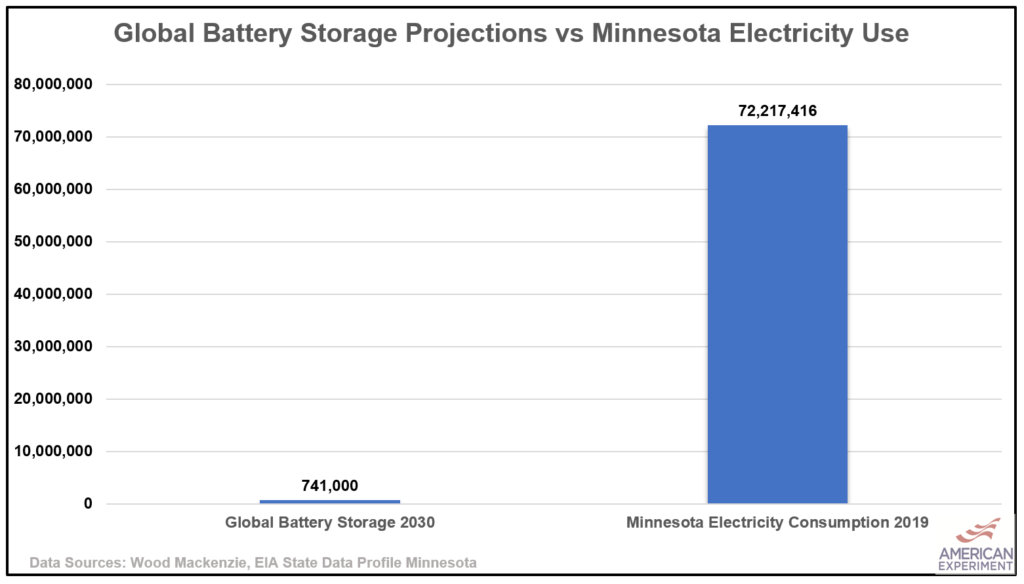
The other impediment to battery storage is cost. The current cost estimate is about $250/KWh of storage capacity. This means that the cost of supplying one percent of Minnesota’s electricity needs with battery storage would be more than $185 billion. Xcel Energy presented this slide to the Midwest Governors Association a few years ago, which shows the cost of electricity in California, assuming all of the electricity is provided using wind, solar, and battery storage.
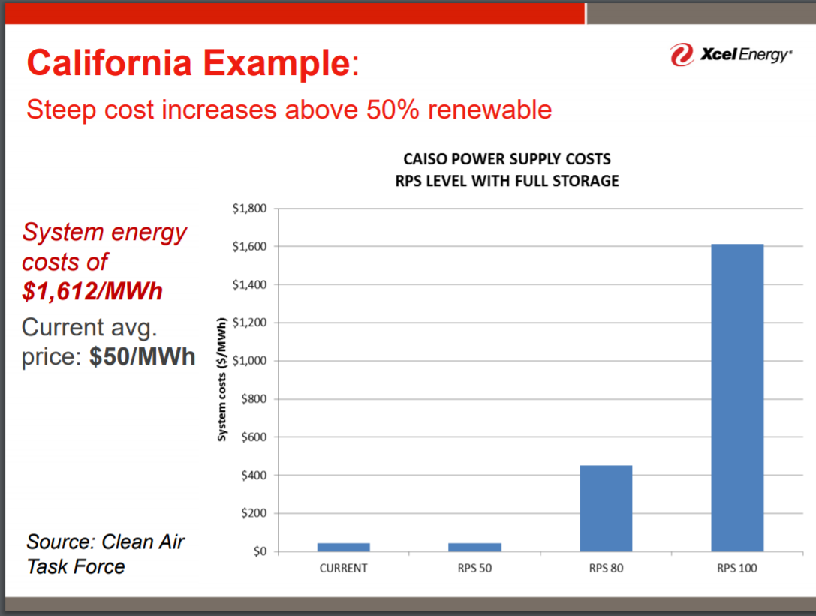
You’ll notice that the cost of electricity increases exponentially as renewable and battery storage penetration increases to $1,612 per megawatt-hour ((MWh) compared to an average system cost of $50 per MWh today.
Under this scenario, electricity prices would be 11 times higher than the current electricity prices for residential customers in Xcel Energy’s service territory. This means the average Minnesota household with Xcel as their energy provider using 648-kilowatt hours per month would see their average monthly bill increase from about $91.30 to $1,036.80, or more than $12,000 per year.
These are enormous costs for immeasurably small environmental benefits.
Massive Costs, Microscopic Benefits
Even if we completely eliminated emissions from all sources in Minnesota, about 161 million tons according to the Minnesota Pollution Control Agency, it would have an immeasurably small impact on future global temperatures.
To understand the global-temperature impact of eliminating greenhouse gas emissions from Minnesota, it helps to examine the temperature impact of the Clean Power Plan (CPP), which was widely considered to be the Obama administration’s signature climate change initiative.
The Obama administration claimed the CPP would have reduced annual CO2 emissions nationally by 730 million metric tons by 2030. The Obama administration’s Environmental Protection Agency used a climate model called the Model for the Assessment of Greenhouse-Gas Induced Climate Change (MAGICC) to determine the CPP’s temperature impact. Using MAGICC, the Obama administration estimated the CPP would have reduced future warming by only 0.019° C by 2100, an amount too small to be accurately measured with even the most sophisticated scientific equipment.
The 161 million tons (146 million metric tons) of CO2 no longer emitted from Xcel Energy’s power plants in Minnesota would account for 20 percent of the 730 million metric tons averted by the CPP. From this figure, we can extrapolate that an emissions-free Minnesota would avert 0.0038 degrees C by 2100, meaning the reductions will have no measurable impact on future global temperatures.
Minnesotans deserve to know the likely temperature impact of policies designed to reduce greenhouse gases so they can determine for themselves whether they think the costs outweigh the benefits.
Energy Innovation
Mankind has been developing better sources of energy since the dawn of time. This is the theme of Vaclav Smil’s book, Energy and Civilization: A History, which I borrowed heavily from in my Thinking Minnesota article “The Future of Energy.” The history of our species can be described as a relentless pursuit of more, and more-useful forms of energy.
Our ingenuity is the reason why we stopped using wind power as a prime mover when fossil fuels became more available.
The core weakness of Ibele’s thinking is his stunning lack of education regarding the history of energy. This weakness is the most glaringly obvious when he describes nuclear as an “old option,” as if mankind has been splitting atoms for a longer period of time than we have used wind-powered machines to perform useful work.
What. A. Joke.
Letter Two:
Orr, who wants to modernize the Republican Party by supporting the existing technologies of nuclear power and Canadian-sourced hydroelectric, has missed the mark. While carbon-free, these sources are quite limited by high cost and environmental issues.
Nuclear power is the most expensive energy option and new plants take far too long to build. We don’t have time — the climate crisis is happening now. There’s also the intractable issue of where and how to store the deadly radioactive waste.
Hydroelectric power is also expensive, with limited suitable resources for expansion and an outsized environmental impact. The dams flood huge areas, destroying forests, wildlife habitat, farmland and sometimes whole communities. They are not a viable answer to our current or future energy needs.
Wind and solar are the lowest-cost sources of energy today and getting lower all the time. It is true that, as these sustainable sources grow, the challenges to managing the electrical grid will also grow. However, battery storage technology is advancing rapidly and the costs are dropping.
Climate change is extracting an extremely high price on the world’s economies. We’ve run out of time to keep hanging on to costly old technologies hoping they alone can save us. Nuclear and hydro energy may remain part of the mix. But low-cost renewable and sustainable energy sources will be the workhorses of the future.
Laurel Regan, Rochester
My Response:
Ms. Regan is respectful in her article, so I’ll be respectful in turn.
Nuclear Waste Isn’t Deadly
First of all, no one has ever died from spent nuclear fuel rods sitting in a concrete cask in a power plant and no one ever will. The average person is exposed to more radiation in an airplane than they are outside of a nuclear power plant.
Comparing the Cost of Nuclear
Nuclear power and hydroelectric power have large up-front capital costs, but in the long run, these technology sources produce some of the lowest-cost, most-reliable, carbon-free power on the planet because they are more productive than wind and solar and the power plants last much longer.
Nuclear power plants are marvels of modern engineering. Minnesota’s existing plants generate 100 percent of their potential, as you can see in the graph below. On the other hand, the best wind turbines in Minnesota only produce about 45 percent of their potential output, and Minnesota’s solar fleet only generates about 18 percent of their potential.
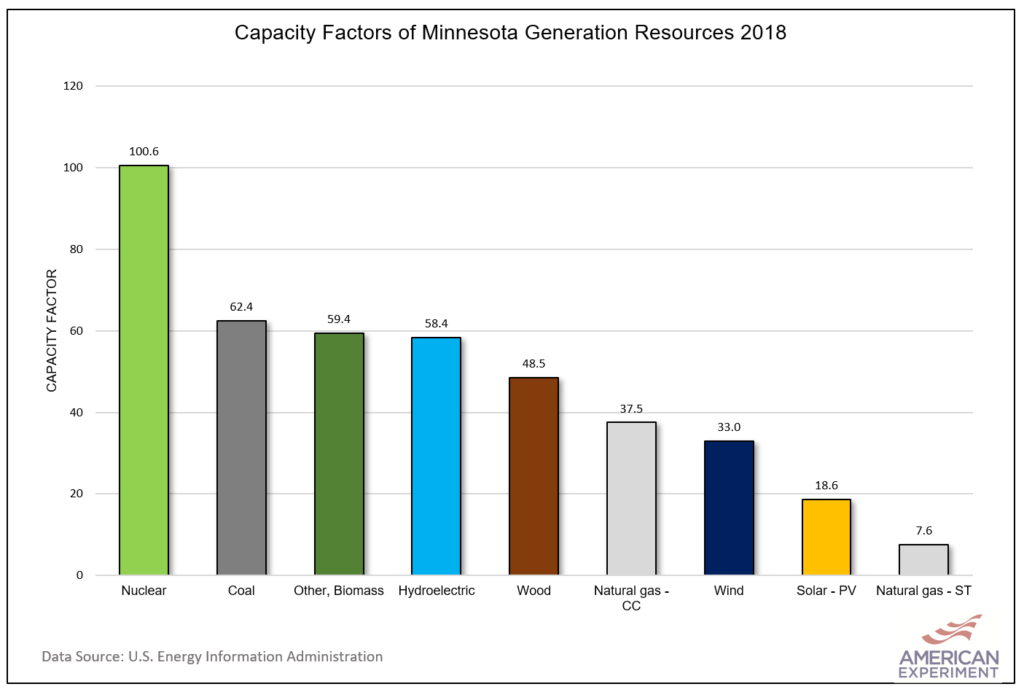
As a result, it would take about 2 to 3 MW of wind, and 5 MW of solar to produce the same amount of electricity as 1 MW of nuclear.
Another huge factor in assessing the value of different energy resources is longevity. Nuclear plants can last for 80 years, and many of the hydroelectric dams built during the 1930’s are still producing massive amounts of electricity today. Wind turbines, on the other hand, don’t even last for 20 years before they are rebuilt and repowered, and solar facilities last for 25 to 30 years.
When we account for the fact that we would need to build about 2 to 3 MW of wind to produce the same output as 1 MW of nuclear, and build 5 MW of solar to produce the same output, and we would need to rebuild the wind turbines three times over 60 years and rebuilt the solar facility twice, nuclear power is much more affordable than these alternatives. Additionally, nuclear doesn’t require backup natural gas plants or battery storage, further demonstrating that nuclear is the superior value.
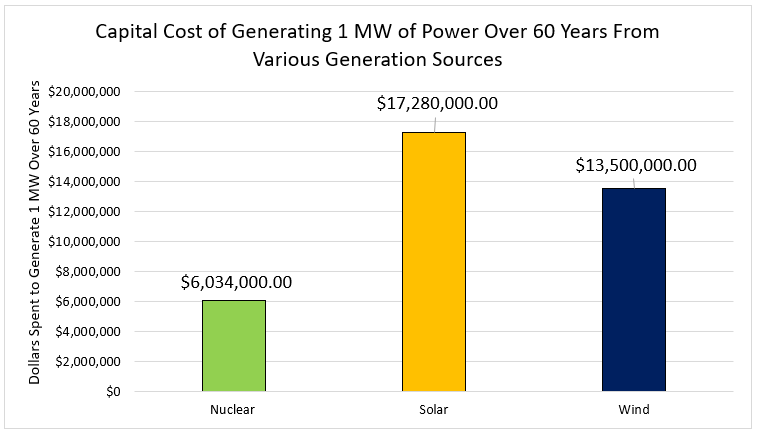
Nuclear Decarbonizes Faster Than Wind, Solar, and Storage
Nuclear plants can take a long time to build, this is absolutely true. But if the author is concerned about time, then nuclear and large hydro are the only answers because the expected global battery capacity in 2030 will be the equivalent of one percent of Minnesota’s 2019 electricity consumption.
The United Arab Emirates is currently in the process of building the Barakah nuclear power facility. Construction began in 2012, and the facility will have four 1400 MW nuclear reactors when it is complete. The first of four reactors will begin commercial operation this year, and construction of the other reactors is nearing completion.
Now that the first plant is generating electricity, we can expect it to generate about 11 million MWh per year, or about 15 times more energy than Wood MacKenzie believes will be stored in batteries by 2030. If time is of the essence, we need to start building new nuclear plants now, and build transmission lines to Canada to utilize electricity generated from the hydroelectric dams that already exist.
Letter 3:
Orr’s opinion piece about the insufficiency and wrongheadedness of society’s embrace of wind and solar power is annoying in that there should be a serious ongoing discussion of how best to slow down the CO2 bulldozer mechanism that causes climate change. However, getting policy statements from the Center of the American Experiment on how to do this is like getting cancer treatment advice from a witch doctor. I guess it’s progress that there was no denial of man-made climate change, but now it is a badmouthing of current green technologies. Certainly, wind and solar have variable output, but they are a very important part of reducing Minnesota’s total CO2 emissions. It was misleading for Orr to suggest that the use of renewables leads to increased costs and that we barely did better than the rest of the country in reducing power plant emissions, but I suspect that was his intent. In actuality, emissions dropped throughout the country because renewable energy sources made coal uncompetitive and coal power plants went offline, eliminating huge amounts of CO2 emissions. If not for states like Minnesota mandating these changes, we would not have the technology where it is today.
I don’t know what the CAE is trying to achieve except slow down the conversion to a sustainable world. I do agree other technologies are needed to get us to a carbon-neutral place, including battery storage, energy efficiency, innovative hydroelectric technology and maybe someday the holy grail of fusion. But to bad-mouth the green technologies because they are imperfect makes me imagine the policy fellows at the Center for the American Experiment in 1903, running up and down the beach at Kitty Hawk, yelling at the Wright brothers that their new technology is too slow, impractical and just a ridiculous waste of money.
David Brockway, Hopkins
My Response:
Mr. Brockway is dead wrong when it he attributes falling carbon dioxide emissions to reneawbles, when in reality most of the reductions were caused by switching from coal to natural gas, which emits half the carbon dioxide. According to the U.S. Energy Information Administration, natural gas displacing coal in electricity generation reduced carbon dioxide emissions by 525 million metric tons, whereas increasing wind and solar averted 330 million metric tons.

This is why Pennsylvania has seen emissions fall by 40 percent since 2007, whereas Minnesota has only seen emissions fall by 34 percent. EIA data show that Minnesota’s electricity prices increased 30 percent faster than Pennsylvania’s, demonstrating that Minnesota’s chosen path to reducing emissions has been less effective and more expensive.
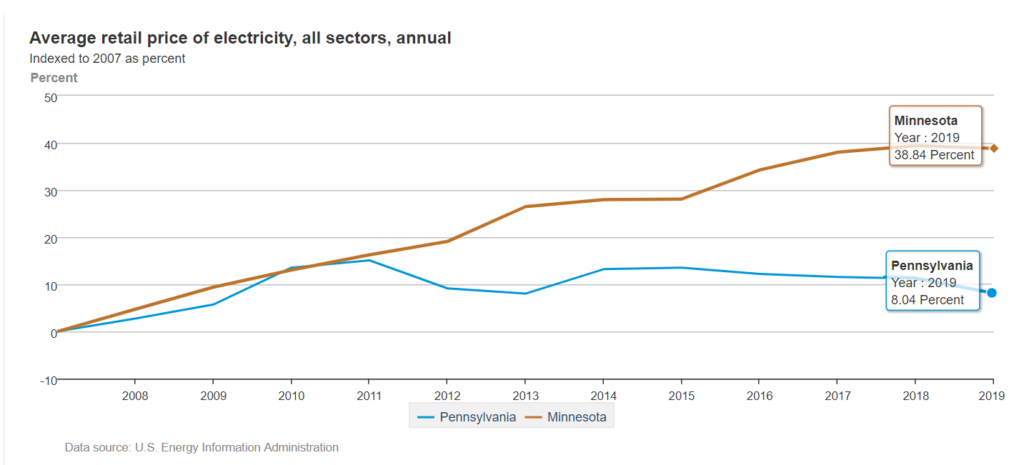
Natural gas was only able to displace coal because of the technological innovation of combining horizontal drilling and hydraulic fracturing, which turned the United States into the largest producer of oil and natural gas in the entire world. I’ve been singing the praises of these new technologies since 2013, and my Twitter handle is still @thefrackingguy.
If we want to reduce emissions, we need to do so by embracing technologies that reduce the cost of energy for consumers, not by mandating expensive and unreliable sources of energy like wind and solar. In other words, it needs to be a win-win.
Fracking enables us to do that, and new nuclear technologies will provide the opportunity to someday beat fossil fuels in terms of price and reliability. Unless there is a cheaper, carbon-free alternative to coal, there is no way China, India, or any other developing country is going to use it.
My prescription to Mr. Brockway is to cut down the name-calling and do a little more reading on energy policy.
Conclusion
There appears to be a misconception that wind and solar are somehow newer than nuclear power, which has only been around since 1956. It’s amazing that civilian nuclear went from being invented in 1956 to generating nearly 10 percent of the nation’s electricity by 1975. For context, wind turbines today produce about 7.3 percent of total output, and the federal wind subsidies have been in effect since 1992.
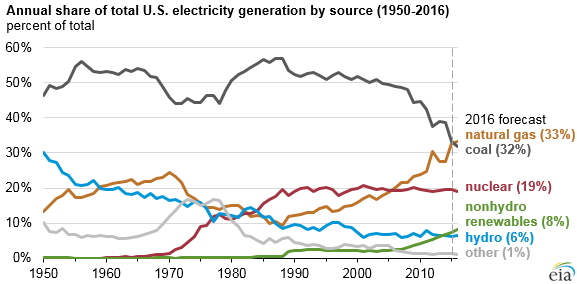
The numbers don’t lie. Batteries are a fantasy, nuclear is the future.